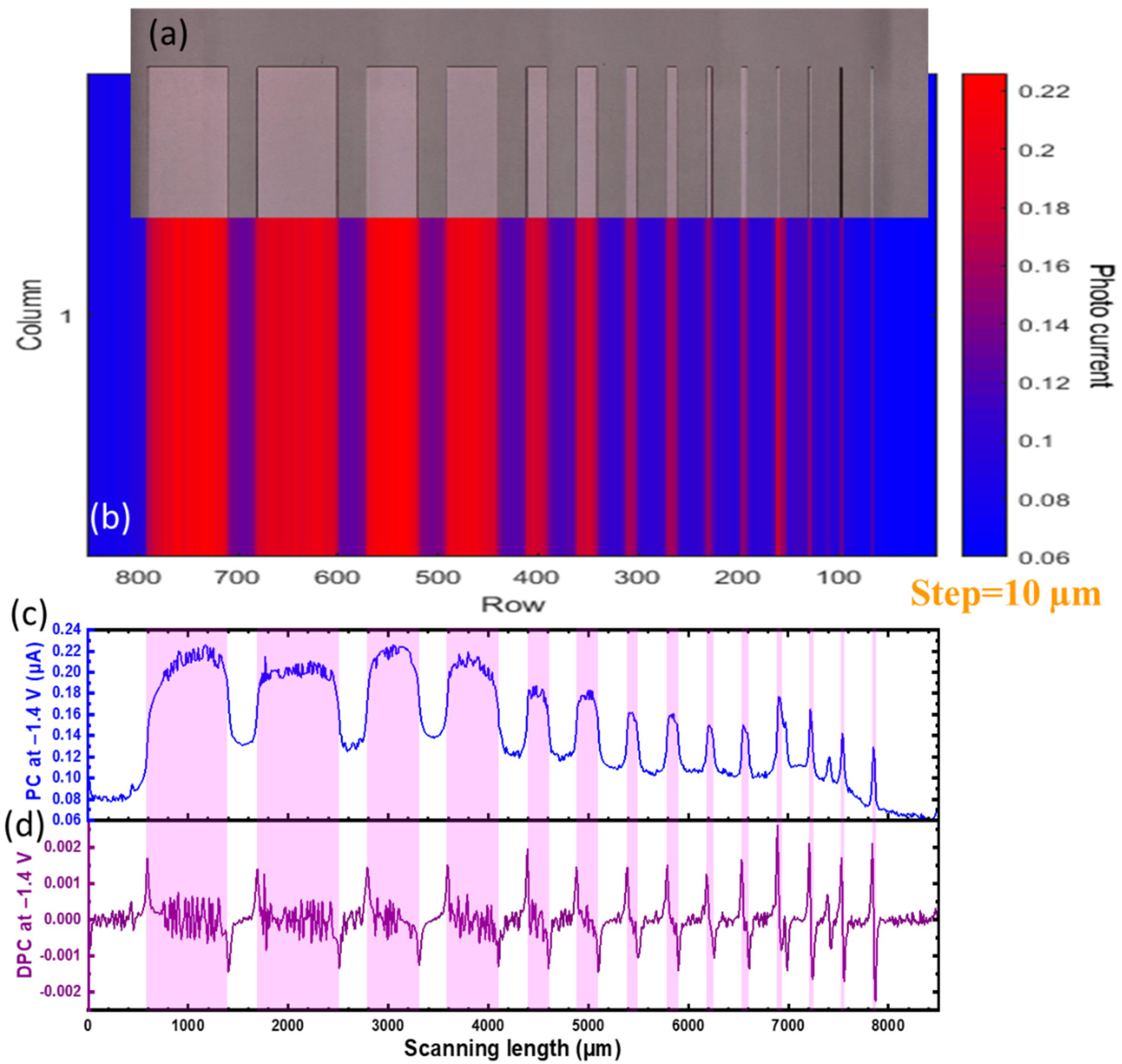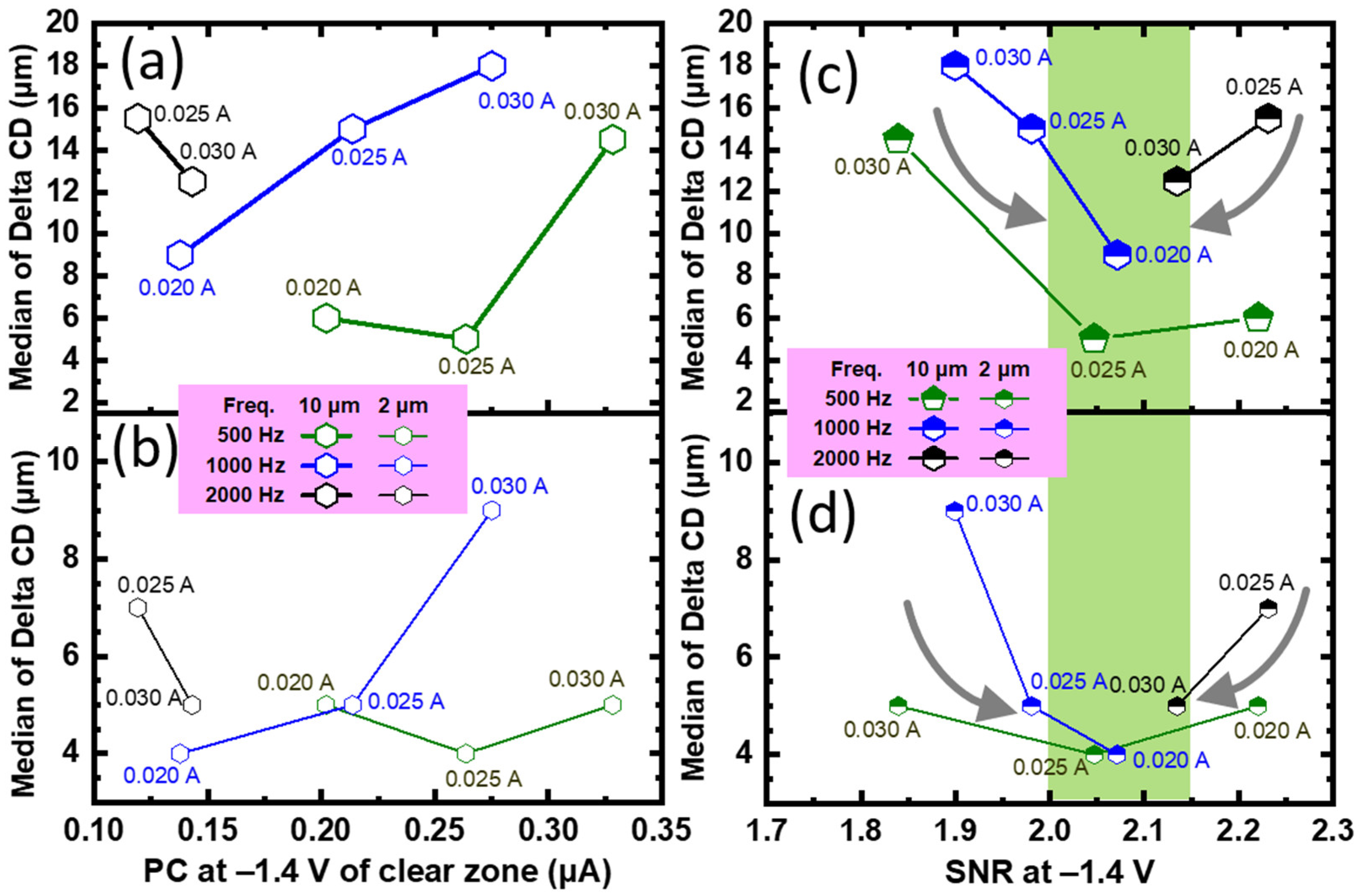Laser Illumination Adjustments for Signal-to-Noise Ratio and Spatial Resolution Enhancement in Static 2D Chemical Images of NbOx/IGZO/ITO/Glass Light-Addressable Potentiometric Sensors
Abstract
:1. Introduction
2. Materials and Methods
3. Results and Discussion
3.1. Basic Characterization of Photoresponse
3.2. Correlation of Photocurrent and Signal-to-Noise Ratio
3.3. Conceptualizing and Formulating the Spatial Resolution
3.4. Spatial Resolution Analysis
4. Conclusions
Supplementary Materials
Author Contributions
Funding
Institutional Review Board Statement
Informed Consent Statement
Data Availability Statement
Acknowledgments
Conflicts of Interest
References
- Liu, D.; Zhang, H.; Fontana, F.; Hirvonen, J.T.; Santos, H.A. Current developments and applications of microfluidic technology toward clinical translation of nanomedicines. Adv. Drug Deliv. Rev. 2018, 128, 54–83. [Google Scholar] [CrossRef] [PubMed] [Green Version]
- Li, L.; Pan, L.; Ma, Z.; Yan, K.; Cheng, W.; Shi, Y.; Yu, G. All Inkjet-Printed Amperometric Multiplexed Biosensors Based on Nanostructured Conductive Hydrogel Electrodes. Nano Lett. 2018, 18, 3322–3327. [Google Scholar] [CrossRef] [PubMed]
- Jung, W.; Han, J.; Choi, J.; Ahn, C.H. Point-of-care testing (POCT) diagnostic systems using microfluidic lab-on-a-chip technologies. Microelectron Eng. 2015, 132, 46–57. [Google Scholar] [CrossRef]
- Sackmann, E.K.; Fulton, A.L.; Beebe, D.J. The present and future role of microfluidics in biomedical research. Nature 2014, 24, 181–189. [Google Scholar] [CrossRef] [PubMed]
- Singh, P. SPR Biosensors: Historical Perspectives and Current Challenges. Sens. Actuators B Chem. 2016, 229, 110–130. [Google Scholar] [CrossRef]
- Goud, K.Y.; Moonla, C.; Mishra, R.K.; Yu, C.; Narayan, R.; Litvan, I.; Wang, J. Wearable Electrochemical Microneedle Sensor for Continuous Monitoring of Levodopa: Toward Parkinson Management. ACS Sens. 2019, 4, 2196–2204. [Google Scholar] [CrossRef]
- Lowe, B.M.; Sun, K.; Zeimpekis, I.; Skylaris, C.K.; Green, N.G. Field-effect sensors–from pH sensing to biosensing: Sensitivity enhancement using streptavidin–biotin as a model system. Analyst 2017, 142, 4173–4200. [Google Scholar] [CrossRef] [PubMed] [Green Version]
- Kaisti, M. Detection principles of biological and chemical FET sensors. Biosens. Bioelectron. 2017, 98, 437–448. [Google Scholar] [CrossRef] [PubMed]
- Pullano, S.A.; Critello, C.D.; Mahbub, I.; Tasneem, N.T.; Shamsir, S.; Islam, S.K.; Greco, M.; Fiorillo, A.S. EGFET-Based Sensors for Bioanalytical Applications: A Review. Sensors 2018, 18, 4042. [Google Scholar] [CrossRef] [Green Version]
- Sakata, T.; Matsumoto, S.; Nakajim, Y.; Miyahara, Y. Potential Behavior of Biochemically Modified Gold Electrode for Extended-Gate Field-Effect Transistor. Jpn. J. Appl. Phys. 2005, 44, 2860–2863. [Google Scholar] [CrossRef]
- Owicki, J.C.; Bousse, L.J.; Hafeman, D.G.; Kirk, G.L.; Olson, J.D.; Wada, H.G.; Parce, J.W. The light-addressable potentiometric sensor: Principles and biological applications. Annu. Rev. Biophys. Biomol. Struct. 1994, 23, 87–113. [Google Scholar] [CrossRef]
- Poghossian, A.; Schöning, M.J. Capacitive Field-Effect EIS Chemical Sensors and Biosensors: A Status Report. Sensors 2020, 20, 5639. [Google Scholar] [CrossRef] [PubMed]
- Parizi, K.B.; Xu, X.; Pal, A.; Hu, X.; Wong, H.S.P. ISFET pH Sensitivity: Counter-Ions Play a Key Role. Sci. Rep. 2017, 7, 41305. [Google Scholar] [CrossRef] [PubMed] [Green Version]
- Lee, C.; Kim, S.K.; Kim, M. Ion-Sensitive Field-Effect Transistor for Biological Sensing. Sensors 2009, 9, 7111–7131. [Google Scholar] [CrossRef] [PubMed]
- Huang, X.; Wang, F.; Guo, J.; Yan, M.; Yu, H.; Yeo, K.S. A 64 × 64 1200 fps CMOS Ion-Image Sensor with Suppressed Fixed-Pattern-Noise for Accurate High-throughput DNA Sequencing. In Proceedings of the 2014 Symposium on VLSI Circuits Digest of Technical Papers, Honolulu, HI, USA, 10–13 June 2014. [Google Scholar]
- Dantism, S.; Takenaga, S.; Wagner, T.; Wagner, P.; Schöning, M.J. Differential imaging of the metabolism of bacteria and eukaryotic cells based on light-addressable potentiometric sensors. Electrochim. Acta 2017, 246, 234–241. [Google Scholar] [CrossRef]
- Yoshinobu, T.; Miyamoto, K.O.; Werner, C.F.; Poghossian, A.; Wagner, T.; Schöning, M.J. Light-Addressable Potentiometric Sensors for Quantitative Spatial Imaging of Chemical Species. Annu. Rev. Anal. Chem. 2017, 10, 225–246. [Google Scholar] [CrossRef]
- Yang, C.; Zeng, W.; Chen, C.; Chen, Y.; Chen, T. Spatial resolution and 2D chemical image of light-addressable potentiometric sensor improved by inductively coupled-plasma reactive-ion etching. Sens. Actuators B Chem. 2018, 258, 1295–1301. [Google Scholar] [CrossRef]
- Miyamoto, K.; Itabashi, A.; Wagner, T.; Schöning, M.J.; Yoshinobu, T. High-speed chemical imaging inside a microfluidic channel. Sens. Actuators B Chem. 2014, 194, 521–527. [Google Scholar] [CrossRef]
- Poghossian, A.; Werner, C.F.; Buniatyan, V.V.; Wagner, T.; Miamoto, K.; Yoshinobu, T.; Schöning, M.J. Towards addressability of light-addressable potentiometric sensors: Shunting effect of non-illuminated region and cross-talk. Sens. Actuators B Chem. 2017, 244, 1071–1079. [Google Scholar] [CrossRef]
- Ipatov, A.; Zinoviev, K.; Abramova, N.; Bratov, A. Light addressable potentiometric sensor array: A new approach for light beam positioning. Procedia Eng. 2010, 5, 625–628. [Google Scholar] [CrossRef] [Green Version]
- Yang, C.; Chiang, T.; Yeh, Y.; Das, A.; Lin, Y.; Chen, T. Sensing and pH-imaging properties of niobium oxide prepared byrapid thermal annealing for electrolyte–insulator–semiconductorstructure and light-addressable potentiometric sensor. Sens. Actuators B Chem. 2015, 207, 858–864. [Google Scholar] [CrossRef]
- Özsoylu, D.; Kizildag, S.; Schöning, M.J.; Wagner, T. Differential chemical imaging of extracellular acidification within microfluidic channels using a plasma-functionalized light-addressable potentiometric sensor (LAPS). Phys. Med. 2020, 10, 100030. [Google Scholar] [CrossRef]
- Liang, T.; Gu, C.; Gan, Y.; Wu, Q.; He, C.; Tu, J.; Pan, Y.; Qiu, Y.; Kong, L.; Wan, H.; et al. Microfluidic chip system integrated with light addressable potentiometric sensor (LAPS) for real-time extracellular acidification detection. Sens. Actuators B Chem. 2019, 301, 127004. [Google Scholar] [CrossRef]
- Hu, N.; Wu, C.; da, H.; Wang, T.; Liu, Q.; Wang, P. A novel microphysiometer based on high sensitivity LAPS and microfluidic system for cellular metabolism study and rapid drug screening. Biosens. Bioelectron. 2013, 40, 167–173. [Google Scholar] [CrossRef] [PubMed]
- Dantism, S.; Röhlen, D.; Dahmen, M.; Wagner, T.; Wagner, P.; Schöning, M.J. LAPS-based monitoring of metabolic responses of bacterial cultures in a paper fermentation broth. Sens. Actuators B Chem. 2020, 320, 128232. [Google Scholar] [CrossRef]
- Guo, Y.; Miyamoto, K.; Wagner, T.; Schöning, M.J.; Yoshinobu, T. Device simulation of the light-addressable potentiometric sensor for the investigation of the spatial resolution. Sens. Actuators B Chem. 2014, 204, 659–665. [Google Scholar] [CrossRef]
- Guo, Y.; Miyamoto, K.; Wagner, T.; Schöning, M.J.; Yoshinobu, T. Theoretical study and simulation of light-addressable potentiometric sensors. Phys. Status Solidi 2014, 211, 1467–1472. [Google Scholar] [CrossRef]
- Zhang, Q. Theoretical analysis and design of submicron-LAPS. Sens. Actuators B Chem. 2005, 105, 304–311. [Google Scholar] [CrossRef]
- Hu, N.; da, H.; Wu, C.; Zhou, J.; Kirsanov, D.; Legin, A.; Wan, P.g. A LAPS array with low cross-talk for non-invasive measurement of cellular metabolism. Sens. Actuator A Phys. 2012, 187, 50–56. [Google Scholar] [CrossRef]
- Chen, D.; Liu, S.; Yin, S.; Liang, J. Light-addressable potentiometric sensor with the micro blind holes substrate. IET Sci. Meas. Technol. 2017, 11, 57–62. [Google Scholar] [CrossRef]
- Yang, C.; Zeng, W.; Chen, Y.; Chen, T. Surface Modification for High Photocurrent and pH Sensitivity in a Silicon-Based Light-Addressable Potentiometric Sensor. IEEE Sens. J. 2018, 18, 2253–2259. [Google Scholar] [CrossRef]
- Chen, L.; Zhou, Y.; Jiang, S.; Kunze, J.; Schmuki, P.; Krause, S. High resolution LAPS and SPIM. Electrochem. Commun. 2010, 2, 758–760. [Google Scholar] [CrossRef]
- Ito, Y. High-spatial resolution LAPS. Sens. Actuators B Chem. 1998, 52, 107–111. [Google Scholar] [CrossRef]
- Yang, C.; Liao, Y.; Chen, C.; Chen, T.; Lai, C.; Pijanowska, D.G. P-I-N amorphous silicon for thin-film light-addressable potentiometric sensors. Sens. Actuators B Chem. 2016, 236, 1005–1010. [Google Scholar] [CrossRef]
- Yang, C.; Chen, C.; Akuli, N.; Yen, T.; Lai, C. A revised manuscript submitted to sensors and actuators B: Chemical illumination modification from an LED to a laser to improve the spatial resolution of IGZO thin film light-addressable potentiometric sensors in pH detections. Sens. Actuators B Chem. 2021, 329, 128953. [Google Scholar] [CrossRef]
- Yang, C.; Chen, C.; Chang, L.; Lai, C. IGZO Thin-Film Light-Addressable Potentiometric Sensor. IEEE Electron Device Lett. 2016, 37, 1481–1484. [Google Scholar] [CrossRef]
- Kamiya, T.; Nomura, K.; Hoson, H.o. Present status of amorphous In–Ga–Zn–O thin-film transistors. Sci. Technol. Adv. Mater. 2010, 11, 44305. [Google Scholar] [CrossRef] [PubMed]
- Das, A.; Das, A.; Chang, L.B.; Lai, C.S.; Lin, R.M.; Chu, F.C.; Lin, Y.H.; Chow, L.; Jeng, M.J. GaN Thin Film Based Light Addressable Potentiometric Sensor for pH Sensing Application. Appl. Phys. Express 2013, 6, 36601. [Google Scholar] [CrossRef]
- Miyamoto, K.O.; Seki, K.; Suto, T.; Werner, C.F.; Wagner, T.; Schöning, M.J.; Yoshinobu, T. Improved spatial resolution of the chemical imaging sensor with a hybrid illumination that suppresses lateral diffusion of photocarriers. Sens. Actuators B Chem. 2018, 273, 1328–1333. [Google Scholar] [CrossRef]
- Tan, J.; Liu, S.; Luo, J.; Li, H. Well-ordered polystyrene colloidal spheres for light addressable potentiometric sensor. Thin Solid Films 2020, 716, 138417. [Google Scholar] [CrossRef]
- Chen, C.; Yang, C.; Chang, L.; Lai, C. Thickness effect of IGZO layer in light-addressable potentiometric sensor. In Proceedings of the 2016 23rd International Workshop on Active-Matrix Flatpanel Displays and Devices (AM-FPD), Kyoto, Japan, 6–8 July 2016. [Google Scholar]
- Fung, T.Z. Amorphous In-Ga-Zn-O Thin Film Transistor for Future Optoelectronics. Ph.D. Dissertation, University of Michigan, Ann Arbor, MI, USA, 2010; pp. 62–63. [Google Scholar]
- Das, A.; Chen, T.; Yang, C.; Lai, C. A high-speed, flexible-scanning chemical imaging system using a light-addressable potentiometric sensor integrated with an analog micromirror. Sens. Actuators B Chem. 2014, 198, 225–232. [Google Scholar] [CrossRef]
- Das, A.; Yang, C.; Chen, T.; Lai, C. Analog micromirror-LAPS for chemical imaging and zoom-in application. Vacuum 2015, 118, 161–166. [Google Scholar] [CrossRef]
- Zhang, D.; Wu, F.; Kraus, S.E. LAPS and SPIM Imaging Using ITO-Coated Glass as the Substrate Material. Anal. Chem. 2017, 89, 8129–8133. [Google Scholar] [CrossRef] [PubMed]






Publisher’s Note: MDPI stays neutral with regard to jurisdictional claims in published maps and institutional affiliations. |
© 2021 by the authors. Licensee MDPI, Basel, Switzerland. This article is an open access article distributed under the terms and conditions of the Creative Commons Attribution (CC BY) license (https://creativecommons.org/licenses/by/4.0/).
Share and Cite
Chen, C.-H.; Akuli, N.; Lu, Y.-J.; Yang, C.-M. Laser Illumination Adjustments for Signal-to-Noise Ratio and Spatial Resolution Enhancement in Static 2D Chemical Images of NbOx/IGZO/ITO/Glass Light-Addressable Potentiometric Sensors. Chemosensors 2021, 9, 313. https://doi.org/10.3390/chemosensors9110313
Chen C-H, Akuli N, Lu Y-J, Yang C-M. Laser Illumination Adjustments for Signal-to-Noise Ratio and Spatial Resolution Enhancement in Static 2D Chemical Images of NbOx/IGZO/ITO/Glass Light-Addressable Potentiometric Sensors. Chemosensors. 2021; 9(11):313. https://doi.org/10.3390/chemosensors9110313
Chicago/Turabian StyleChen, Chun-Hui, Neelanjan Akuli, Yu-Jen Lu, and Chia-Ming Yang. 2021. "Laser Illumination Adjustments for Signal-to-Noise Ratio and Spatial Resolution Enhancement in Static 2D Chemical Images of NbOx/IGZO/ITO/Glass Light-Addressable Potentiometric Sensors" Chemosensors 9, no. 11: 313. https://doi.org/10.3390/chemosensors9110313
APA StyleChen, C.-H., Akuli, N., Lu, Y.-J., & Yang, C.-M. (2021). Laser Illumination Adjustments for Signal-to-Noise Ratio and Spatial Resolution Enhancement in Static 2D Chemical Images of NbOx/IGZO/ITO/Glass Light-Addressable Potentiometric Sensors. Chemosensors, 9(11), 313. https://doi.org/10.3390/chemosensors9110313





